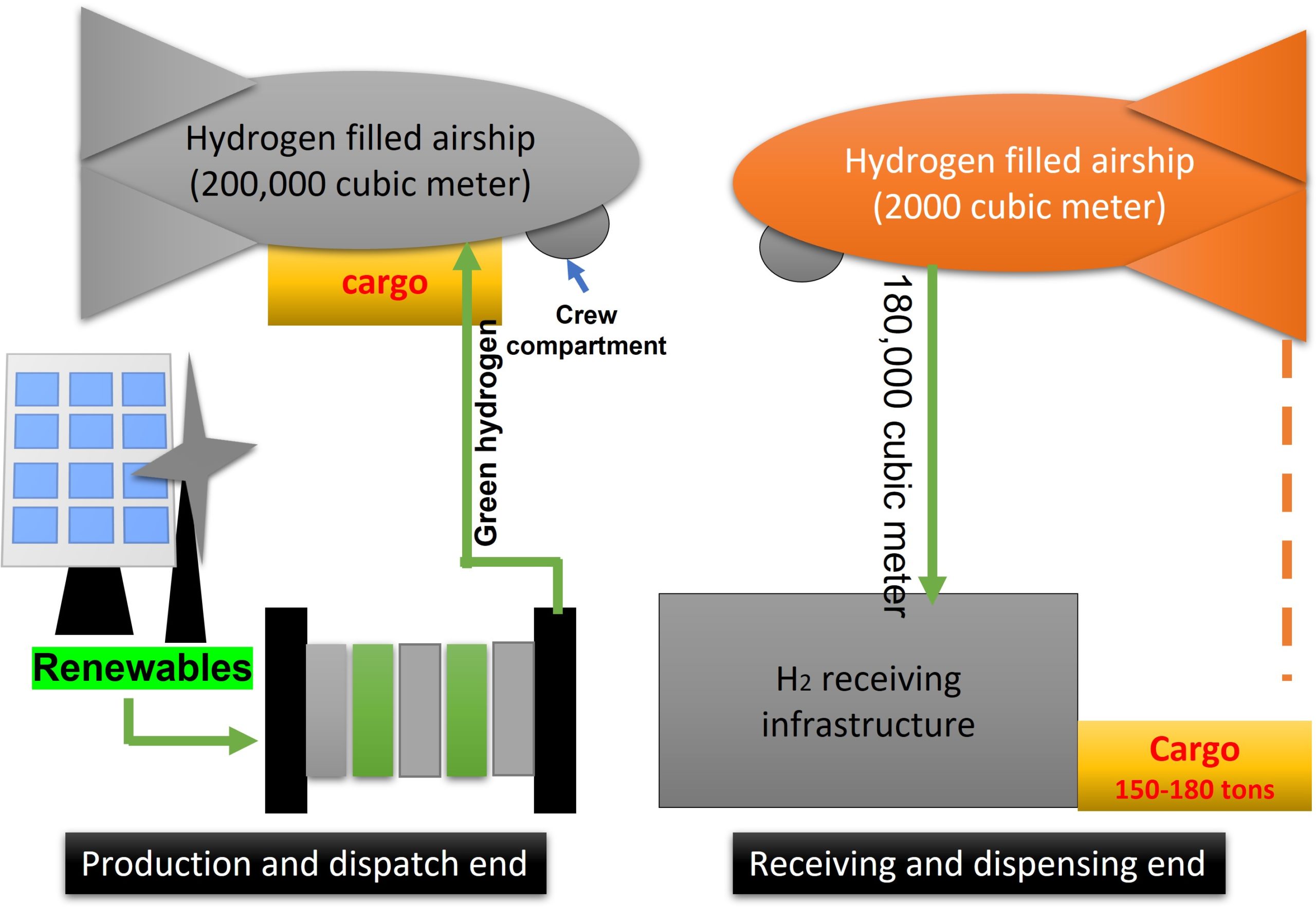Green hydrogen has garnered much interest in various energy and non-energy sectors globally due to its ability to decarbonize even hard to electrify sectors such as the iron and steel industries. One major challenge, however, is its costly long-distance transportation.
Hydrogen has the potential for the deep decarbonization of the total primary energy mix due to its relative ease in transportation and its usage similarity with natural gas as an energy carrier. Recent government policies and huge investment in the hydrogen economy further assert its importance as an emissions-free fuel of the future.
Currently, two main hydrogen production routes are in competition: (i) steam methane reforming with carbon capture & sequestration; and (ii) green hydrogen which uses renewable energy and water to produce hydrogen. The third, and probably the most cost-effective technology (production costs have been claimed to be less than 1USD/kg), is the underground processing of fossil reserves still present in abandoned wells, i.e., so-called proton technology.
When it comes to the use of renewables and converting the current electric grid to 100% renewables, green hydrogen offers a decisive edge over currently available long-term storage and energy transportation. The intermittency of renewables can largely be minimized by employing hydrogen as a storage asset in the electrical grid.
Furthermore, its cost-effective long-distance transportation through new or repurposed pipelines enables rural/remote areas to be easily connected to national grids. However, the involved capital investment for new pipelines for hydrogen transportation dictates the use of ships to transport hydrogen in liquid form, in the form of ammonia, or using liquid organic compounds such as toluene.
In this article, I would like to point towards a renewed interest in airship transportation. The idea of hydrogen-filled airships is not new; but, it was abandoned following the Hindenburg disaster. However, current technological advances mean hydrogen technology, safety, detection, and transportation have been improved upon. Now, renewed interest in airships as a hydrogen transport method may prove to be the most cost-effective and safe approach towards the hydrogen economy.

Current transportation methods and safety concerns
Ocean shipping in various forms (liquid hydrogen, liquid organic hydrogen carriers (LOHC), ammonia etc.,) or pipelines (compressed hydrogen) are the two most feasible long-distance transportation methods. The cost of these was estimated to be 0.4- – 0.60€/kg for 48 inches of re-purposed pipelines, 0.5 – 0.7€/kg for 36 inches of re-purposed pipelines, 0.55 – 0.6€/kg for LCOH shipping, 0.65 – 0.75€/kg for ammonia shipping, 0.9 – 1.0€/kg for 48 inches new pipeline and 1.00 – 1.20€/kg for liquified hydrogen transportation at distances between 5,500 – 6,000 km.
In terms of safety, almost all the methods are prone to fire-related accidents due to the high evaporation rates of hydrogen in the case of liquified hydrogen shipping. Moreover, toluene and ammonia are flammable and explosive liquids. Thus, great care should be exercised when transporting and handling these liquids.
A H2 filled airship
The concept of hydrogen-filled airships dates back to the era of the German Zeppelin’s dominance i.e., 1900 A.D. Reimagined, the new concept embodies the visualization of the “buoyancy force of hydrogen to transport hydrogen”. Before the Hindenburg disaster, more than 100 zeppelins were constructed and operated under both civilian and military role.
However, with advancements in technology, it could be argued that hydrogen-filled zeppelins are a viable transportation alternative. For instance, assume a big, compressed hydrogen-filled airship with solar photovoltaic integrated drive propellers. The airship, with a minimal crew or even remotely operated, travels above oceans from one country to another to dispense compressed hydrogen, leaving only the amount of hydrogen in its tanks required to fly back home.
Consider the example of the Hindenburg: This zeppelin was filled with 200,000m3 of hydrogen, giving it around 230 tons of lifting capacity (one kg of hydrogen can provide 8 – 10 kg lift capacity). Assuming roughly 10-15 tons of dead weight from the rigid frame of the Hindenburg, it needs just 5-10% of hydrogen to keep it afloat.
The rest can be dispensed at the purchase point and the zeppelin can return home easily. Further, the returning airship will have less compressed hydrogen which would minimize leakage risks. The equivalent lift of dispensable hydrogen can be used to transport cargo. Furthermore, with the average flying speed of the Hindenburg (130 km/h), transportation times can be reduced by two to three times compared to the average speed of cruise ships.
Another advantage of the proposed concept is its decisive edge over the two competing technologies, i.e., pipelines and shipping in terms of capital and maintenance costs.
Challenges
There is no doubt about the flammability and explosion potential of compressed hydrogen due to heat accumulation; however, the current state-of-the-art lightweight materials with flame retardant coatings and improved cooling mechanisms can minimize the risk of heat-induced triggers.
Secondly, the rigid structure of the airship must be lightweight and strong enough to reduce dead weight. Current carbon fiber composite-based technologies can play a potential role in this regard.
Hydrogen leak detection and its mitigation or isolation is also a highly demanding task and can potentially be addressed through improved hydrogen detection sensors and IoT-based controls. The protection of the cabin crew should be prioritized by using heat and explosion-resistant materials.
Recommendations
- The design of the airships should incorporate state-of-the-art concepts related to hydrogen-filled tank isolation when leakage or any hazard has been detected.
- The construction materials in building rigid structures should be carefully selected based on the properties of hydrogen, heat accumulation, and strength-to-weight ratio
- The hydrogen sensors should be carefully designed and located to avoid leakage-related risks.
- The structure's cooling system should be carefully employed to avoid it heating up which may lead to the ignition of hydrogen.
About the author
 Dr. Muhammad Shakeel Ahmad is a researcher and Hydrogen technology expert in UM power energy at the dedicated advance center, University of Malaya, Kuala Lumpur, Malaysia. He completed his PhD in “renewable energy (materials) engineering” in December 2018 with thesis distinction. His core research areas are renewable energy conversion materials and integrated systems with a special focus on thin-film solar cells, hydrogen generation, and policy development for renewable sources.
Dr. Muhammad Shakeel Ahmad is a researcher and Hydrogen technology expert in UM power energy at the dedicated advance center, University of Malaya, Kuala Lumpur, Malaysia. He completed his PhD in “renewable energy (materials) engineering” in December 2018 with thesis distinction. His core research areas are renewable energy conversion materials and integrated systems with a special focus on thin-film solar cells, hydrogen generation, and policy development for renewable sources.
The views and opinions expressed in this article are the author’s own, and do not necessarily reflect those held by pv magazine.
This content is protected by copyright and may not be reused. If you want to cooperate with us and would like to reuse some of our content, please contact: editors@pv-magazine.com.



2 comments
By submitting this form you agree to pv magazine using your data for the purposes of publishing your comment.
Your personal data will only be disclosed or otherwise transmitted to third parties for the purposes of spam filtering or if this is necessary for technical maintenance of the website. Any other transfer to third parties will not take place unless this is justified on the basis of applicable data protection regulations or if pv magazine is legally obliged to do so.
You may revoke this consent at any time with effect for the future, in which case your personal data will be deleted immediately. Otherwise, your data will be deleted if pv magazine has processed your request or the purpose of data storage is fulfilled.
Further information on data privacy can be found in our Data Protection Policy.